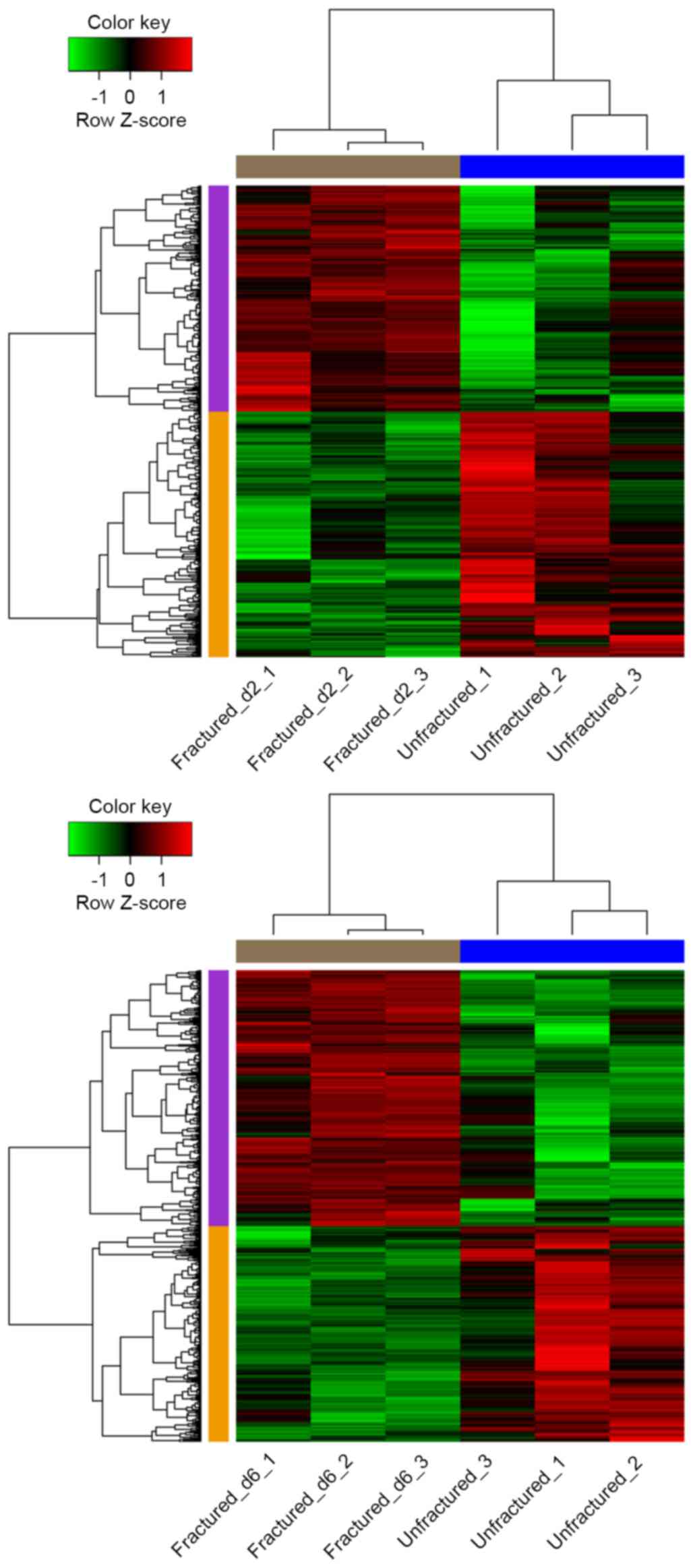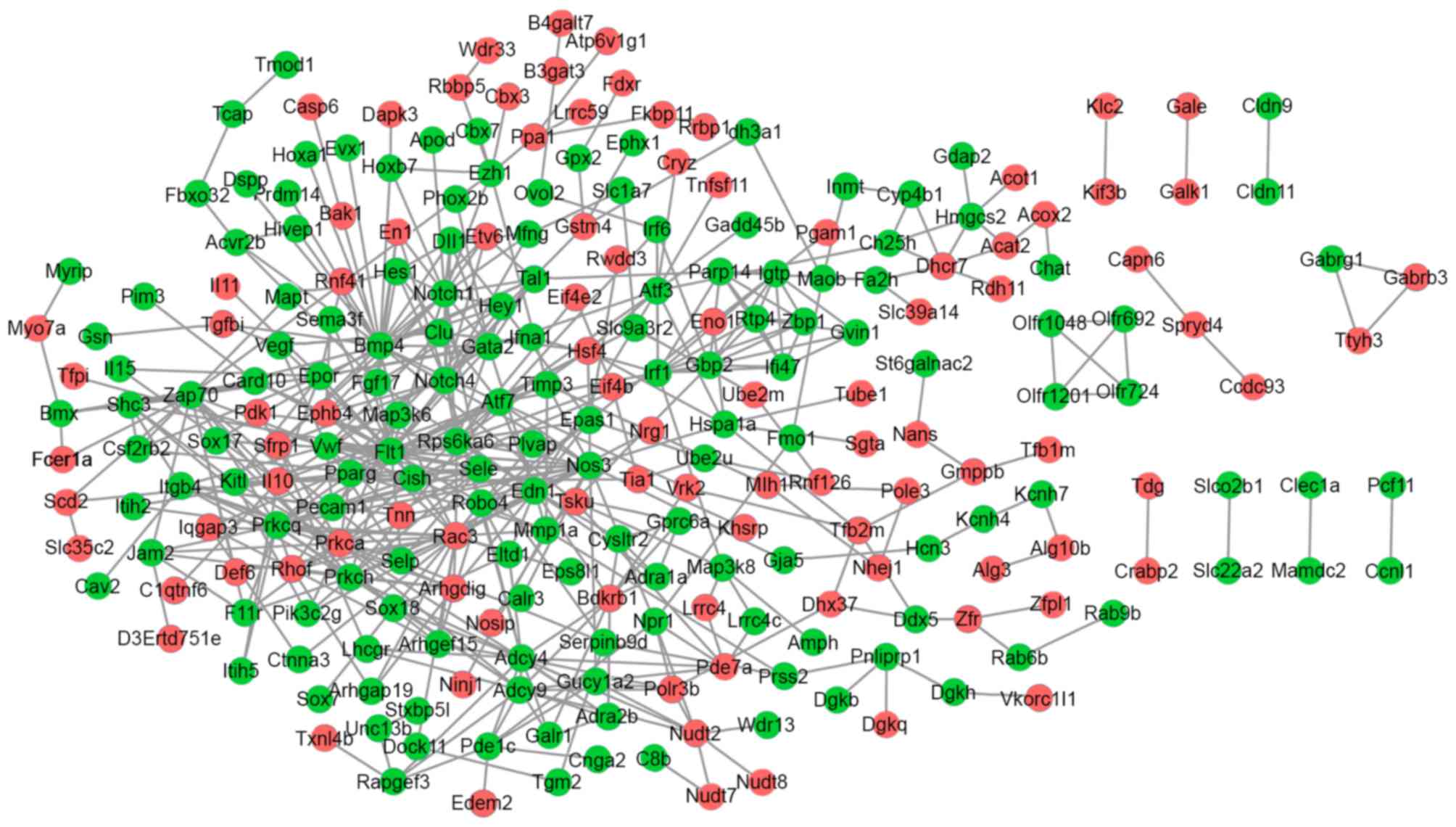|
1
|
Marsell R and Einhorn TA: The biology of
fracture healing. Injury. 42:551–555. 2011. View Article : Google Scholar : PubMed/NCBI
|
|
2
|
Gerstenfeld LC, Cullinane DM, Barnes GL,
Graves DT and Einhorn TA: Fracture healing as a post-natal
developmental process: Molecular, spatial, and temporal aspects of
its regulation. J Cell Biochem. 88:873–884. 2003. View Article : Google Scholar : PubMed/NCBI
|
|
3
|
Wan C, Shao J, Gilbert SR, Riddle RC, Long
F, Johnson RS, Schipani E and Clemens TL: Role of HIF-1alpha in
skeletal development. Ann N Y Acad Sci. 1192:322–326. 2010.
View Article : Google Scholar : PubMed/NCBI
|
|
4
|
Al-Sebaei MO, Daukss DM, Belkina AC, Kakar
S, Wigner NA, Cusher D, Graves D, Einhorn T, Morgan E and
Gerstenfeld LC: Role of Fas and Treg cells in fracture healing as
characterized in the Fas-Deficient (lpr) mouse model of lupus. J
Bone Miner Res. 29:1478–1491. 2014. View Article : Google Scholar : PubMed/NCBI
|
|
5
|
Grcevic D, Pejda S, Matthews BG, Repic D,
Wang L, Li H, Kronenberg MS, Jiang X, Maye P, Adams DJ, et al: In
vivo fate mapping identifies mesenchymal progenitor cells. Stem
cells. 30:187–196. 2012. View
Article : Google Scholar : PubMed/NCBI
|
|
6
|
Kalajzic Z, Li H, Wang LP, Jiang X,
Lamothe K, Adams DJ, Aguila HL, Rowe DW and Kalajzic I: Use of an
alpha-smooth muscle actin GFP reporter to identify an
osteoprogenitor population. Bone. 43:501–510. 2008. View Article : Google Scholar : PubMed/NCBI
|
|
7
|
Roguljic H, Matthews B, Yang W, Cvija H,
Mina M and Kalajzic I: In vivo identification of periodontal
progenitor cells. J Dent Res. 92:709–715. 2013. View Article : Google Scholar : PubMed/NCBI
|
|
8
|
Matthews BG, Grcevic D, Wang L, Hagiwara
Y, Roguljic H, Joshi P, Shin DG, Adams DJ and Kalajzic I: Analysis
of αSMA-labeled progenitor cell commitment identifies notch
signaling as an important pathway in fracture healing. J Bone Miner
Res. 29:1283–1294. 2014. View Article : Google Scholar : PubMed/NCBI
|
|
9
|
Shen J, Zhang J, Luo X, Zhu W, Yu K, Chen
K, Li Y and Jiang H: Predicting protein-protein interactions based
only on sequences information. Proc Natl Acad Sci USA.
104:4337–4341. 2007. View Article : Google Scholar : PubMed/NCBI
|
|
10
|
Smyth GK: Limma: linear models for
microarray dataBioinformatics and computational biology solutions
using R and Bioconductor. Springer; New York, NY: pp. 397–420.
2005, View Article : Google Scholar
|
|
11
|
Huang DW, Sherman BT, Tan Q, Collins JR,
Alvord WG, Roayaei J, Stephens R, Baseler MW, Lane HC and Lempicki
RA: The DAVID gene functional classification tool: A novel
biological module-centric algorithm to functionally analyze large
gene lists. Genome Biol. 8:R1832007. View Article : Google Scholar : PubMed/NCBI
|
|
12
|
Szklarczyk D, Franceschini A, Wyder S,
Forslund K, Heller D, Huerta-Cepas J, Simonovic M, Roth A, Santos
A, Tsafou KP, et al: STRING v10: Protein-protein interaction
networks, integrated over the tree of life. Nucleic Acids Res.
43:D447–D452. 2015. View Article : Google Scholar : PubMed/NCBI
|
|
13
|
Kohl M, Wiese S and Warscheid B:
Cytoscape: Software for visualization and analysis of biological
networks. Methods Mol Biol. 696:291–303. 2011. View Article : Google Scholar : PubMed/NCBI
|
|
14
|
Sawano A, Takahashi T, Yamaguchi S and
Shibuya M: The phosphorylated 1169-tyrosine containing region of
flt-1 kinase (VEGFR-1) is a major binding site for PLCgamma.
Biochem Biophys Res Commun. 238:487–491. 1997. View Article : Google Scholar : PubMed/NCBI
|
|
15
|
Yang YQ, Tan YY, Wong R, Wenden A, Zhang
LK and Rabie AB: The role of vascular endothelial growth factor in
ossification. Int J Oral Sci. 4:64–68. 2012. View Article : Google Scholar : PubMed/NCBI
|
|
16
|
Chu TW, Liu YG, Wang ZG, Zhu PF and Liu
LD: Vascular endothelial growth factor and its receptor expression
during the process of fracture healing. Chin J Traumatol.
11:161–164. 2008. View Article : Google Scholar : PubMed/NCBI
|
|
17
|
Marsden PA, Schappert KT, Chen HS, Flowers
M, Sundell CL, Wilcox JN, Lamas S and Michel T: Molecular cloning
and characterization of human endothelial nitric oxide synthase.
FEBS Lett. 307:287–293. 1992. View Article : Google Scholar : PubMed/NCBI
|
|
18
|
Armour KE, Armour KJ, Gallagher ME,
Gödecke A, Helfrich MH, Reid DM and Ralston SH: Defective bone
formation and anabolic response to exogenous estrogen in mice with
targeted disruption of endothelial nitric oxide synthase.
Endocrinology. 142:760–766. 2001. View Article : Google Scholar : PubMed/NCBI
|
|
19
|
Szczesny G, Olszewski WL and Zaleska M:
Limb lymph node response to bone fracture. Lymphat Res Biol.
2:155–164. 2004. View Article : Google Scholar : PubMed/NCBI
|
|
20
|
Suganthalakshmi B, Anand R, Kim R,
Mahalakshmi R, Karthikprakash S, Namperumalsamy P and Sundaresan P:
Association of VEGF and eNOS gene polymorphisms in type 2 diabetic
retinopathy. Mol Vis. 12:336–341. 2006.PubMed/NCBI
|
|
21
|
Shore EM, Xu M, Shah PB, Janoff HB, Hahn
GV, Deardorff MA, Sovinsky L, Spinner NB, Zasloff MA, Wozney JM and
Kaplan FS: The human bone morphogenetic protein 4 (BMP-4) gene:
Molecular structure and transcriptional regulation. Calcif Tissue
Int. 63:221–229. 1998. View Article : Google Scholar : PubMed/NCBI
|
|
22
|
Reddi A: Initiation of fracture repair by
bone morphogenetic proteins. Clin Orthop Relat Res. 355
Suppl:S66–S72. 1998. View Article : Google Scholar : PubMed/NCBI
|
|
23
|
Lin L, Fu X, Zhang X, Chen LX, Zhang JY,
Yu CL, Ma KT and Zhou CY: Rat adipose-derived stromal cells
expressing BMP4 induce ectopic bone formation in vitro and in vivo.
Acta Pharmacol Sin. 27:1608–1615. 2006. View Article : Google Scholar : PubMed/NCBI
|
|
24
|
Dishowitz MI, Mutyaba PL, Takacs JD, Barr
AM, Engiles JB, Ahn J and Hankenson KD: Systemic inhibition of
canonical notch signaling results in sustained callus inflammation
and alters multiple phases of fracture healing. PLoS One.
8:e687262013. View Article : Google Scholar : PubMed/NCBI
|
|
25
|
Wang C, Shen J, Yukata K, Inzana JA,
O'Keefe RJ, Awad HA and Hilton MJ: Transient gamma-secretase
inhibition accelerates and enhances fracture repair likely via
Notch signaling modulation. Bone. 73:77–89. 2015. View Article : Google Scholar : PubMed/NCBI
|
|
26
|
Okamura H, Proia T, Bell A, Liu Q,
Siddiquee Z, Lin J and Gyuris J: Notch1 monoclonal antibody
inhibits tumor growth and modulates angiogenesis. Cancer Res.
74:2990. 2014. View Article : Google Scholar
|
|
27
|
Zhu J, Liu Q, Jiang Y, Wu L, Xu G and Liu
X: Enhanced angiogenesis promoted by human umbilical mesenchymal
stem cell transplantation in stroked mouse is Notch1 signaling
associated. Neuroscience. 290:288–299. 2015. View Article : Google Scholar : PubMed/NCBI
|
|
28
|
Nobta M, Tsukazaki T, Shibata Y, Xin C,
Moriishi T, Sakano S, Shindo H and Yamaguchi A: Critical regulation
of bone morphogenetic protein-induced osteoblastic differentiation
by Delta1/Jagged1-activated Notch1 signaling. J Biol Chem.
280:15842–15848. 2005. View Article : Google Scholar : PubMed/NCBI
|
|
29
|
Haataja L, Groffen J and Heisterkamp N:
Characterization of RAC3, a novel member of the Rho family. J Biol
Chem. 272:20384–20388. 1997. View Article : Google Scholar : PubMed/NCBI
|
|
30
|
Hajdo-Milasinovic A, van der Kammen RA,
Moneva Z and Collard JG: Rac3 inhibits adhesion and differentiation
of neuronal cells by modifying GIT1 downstream signaling. J Cell
Sci. 122:2127–2136. 2009. View Article : Google Scholar : PubMed/NCBI
|
|
31
|
Magalhaes JK, Grynpas MD, Willett TL and
Glogauer M: Deleting Rac1 improves vertebral bone quality and
resistance to fracture in a murine ovariectomy model. Osteoporosis
Int. 22:1481–1492. 2011. View Article : Google Scholar
|
|
32
|
Li G, White G, Connolly C and Marsh D:
Cell proliferation and apoptosis during fracture healing. J Bone
Miner Res. 17:791–799. 2002. View Article : Google Scholar : PubMed/NCBI
|
|
33
|
Li X, Wang H, Touma E, Rousseau E, Quigg
RJ and Ryaby JT: Genetic network and pathway analysis of
differentially expressed proteins during critical cellular events
in fracture repair. J Cell Biochem. 100:527–543. 2007. View Article : Google Scholar : PubMed/NCBI
|
|
34
|
Li X, Wang H, Touma E, Qi Y, Rousseau E,
Quigg RJ and Ryaby JT: TP508 accelerates fracture repair by
promoting cell growth over cell death. Biochem Biophys Res Commun.
364:187–193. 2007. View Article : Google Scholar : PubMed/NCBI
|











